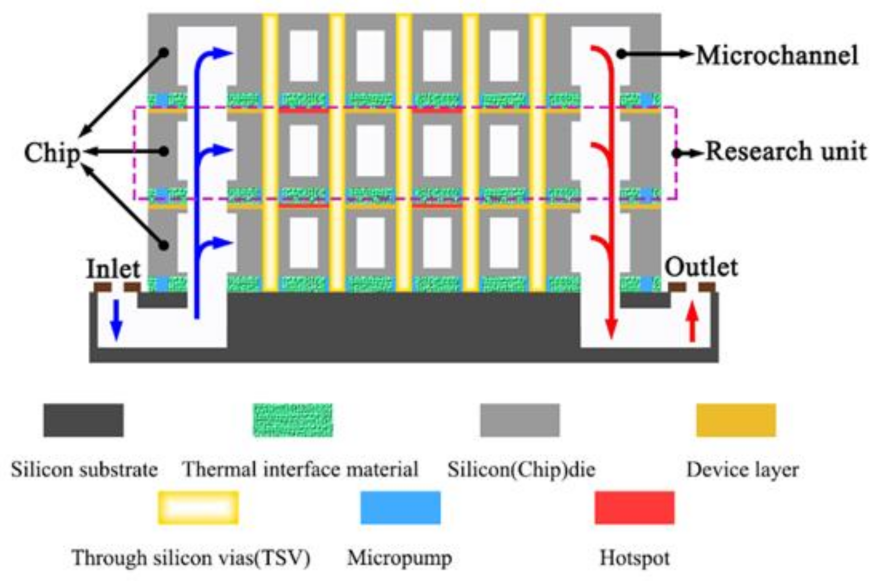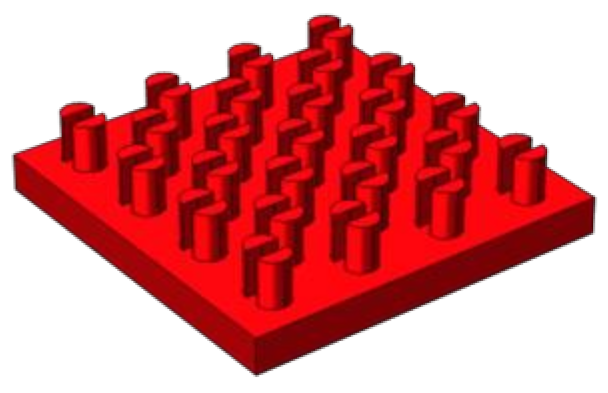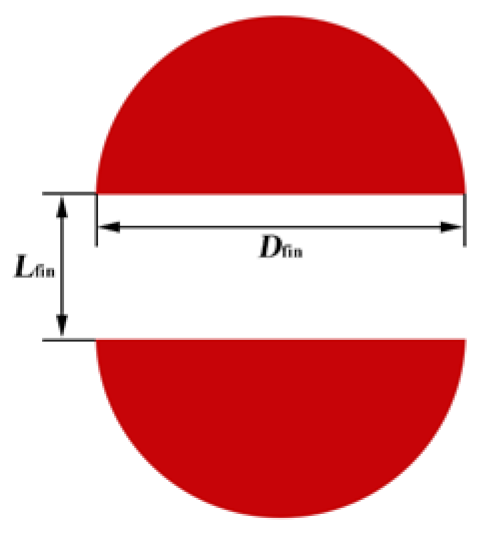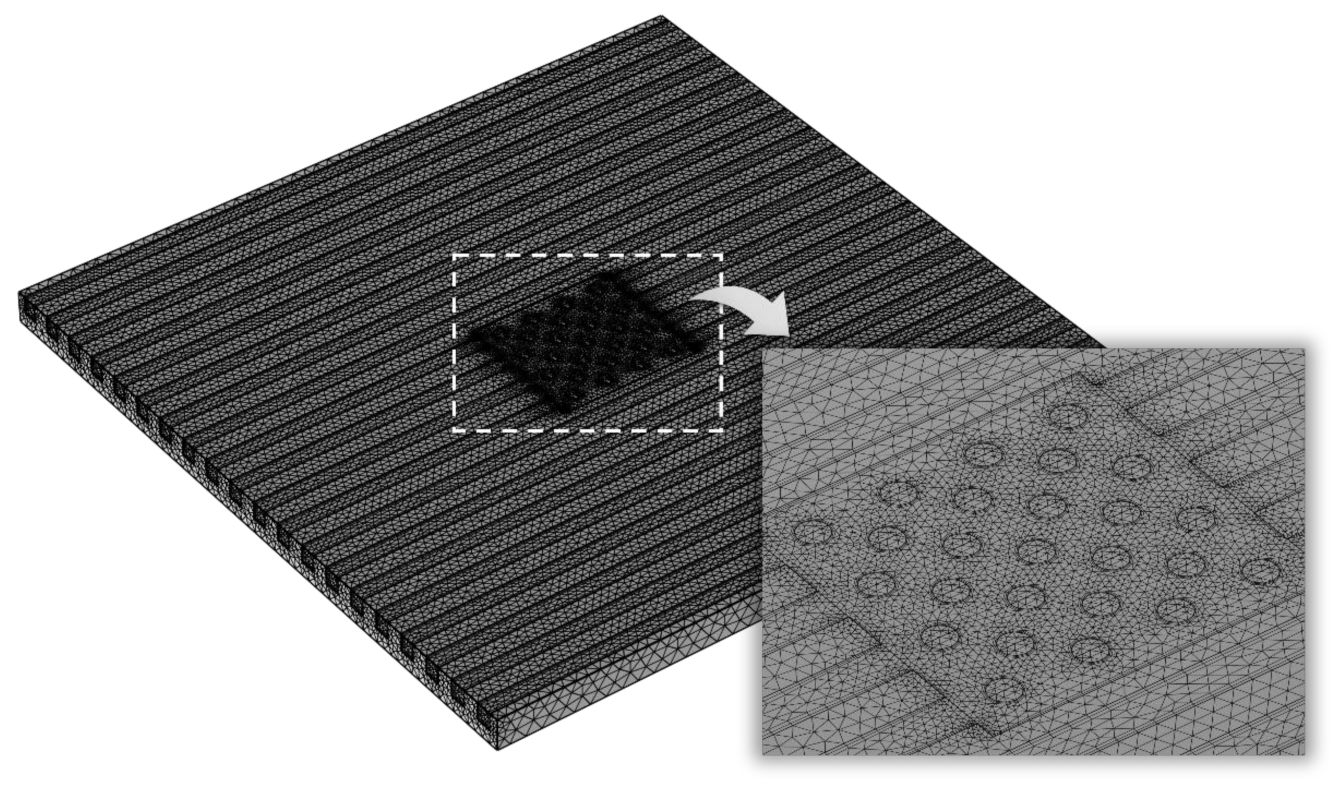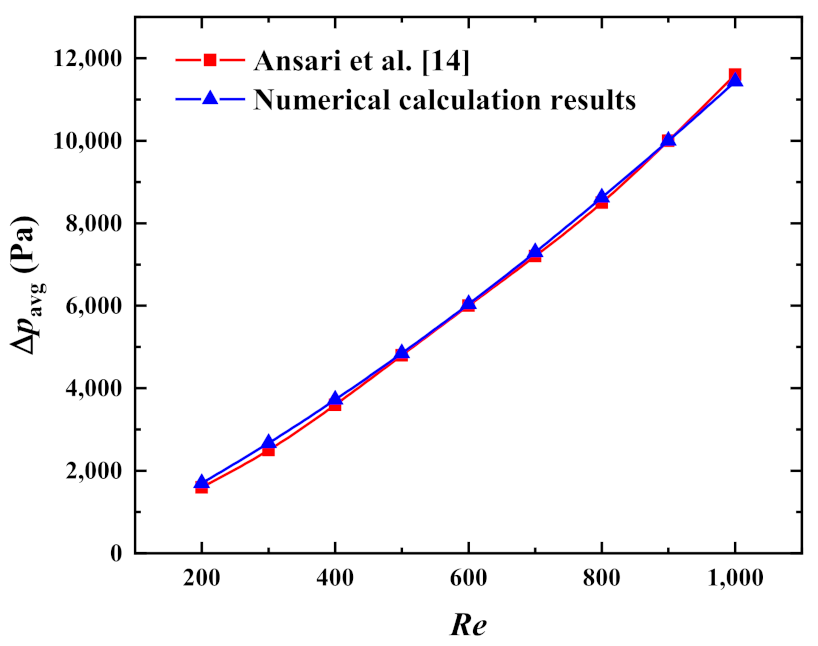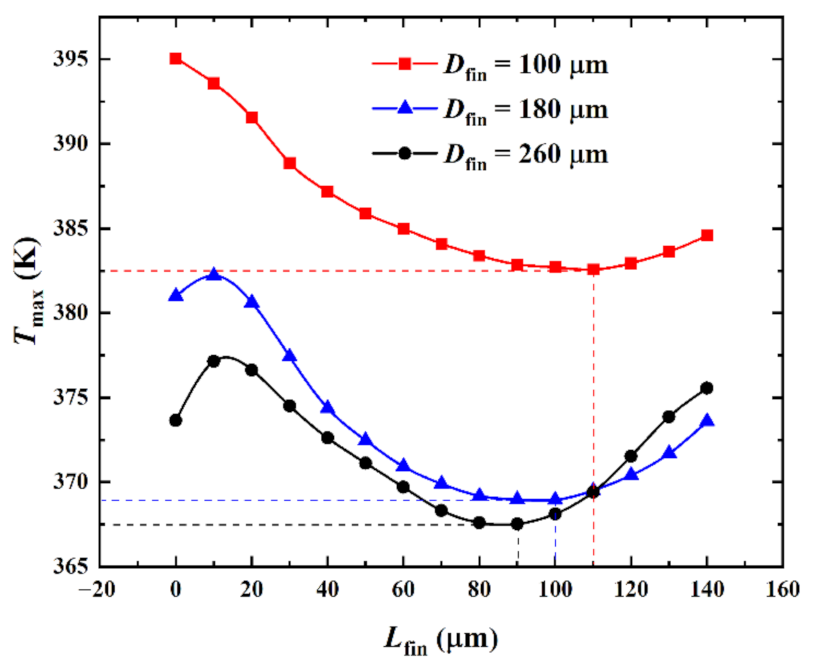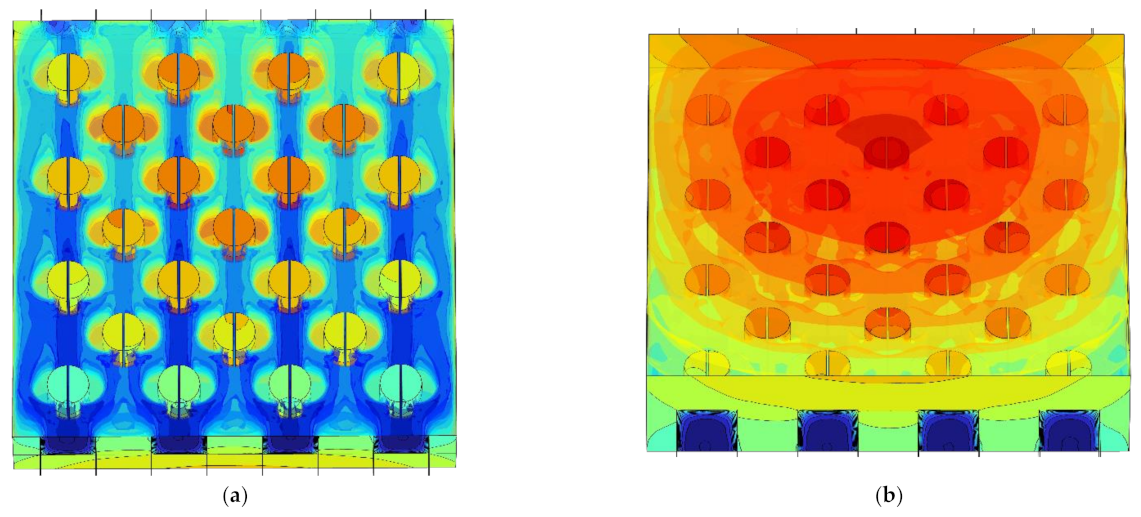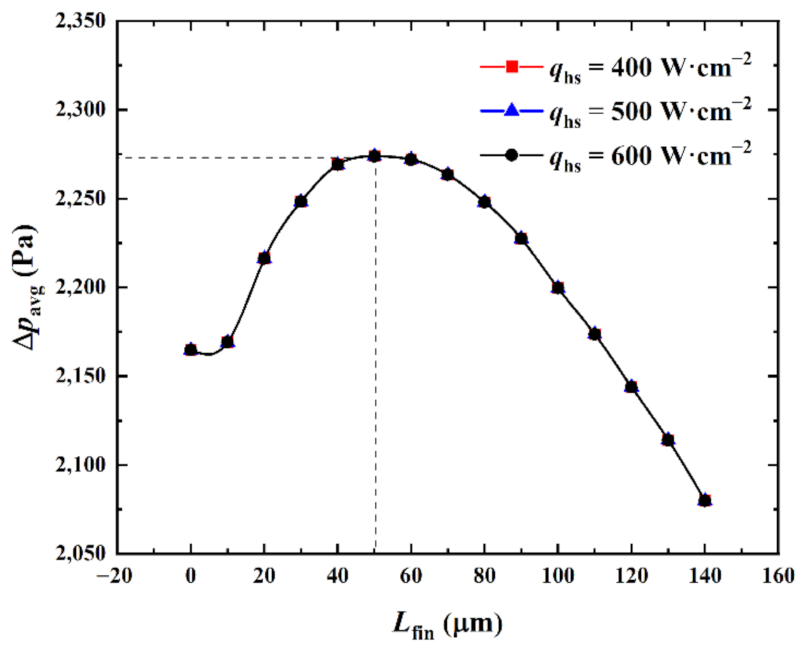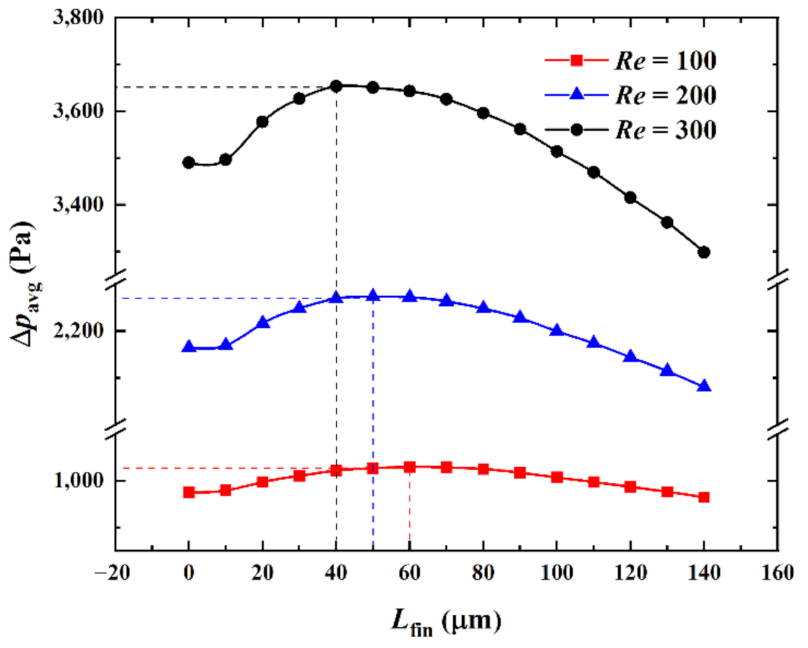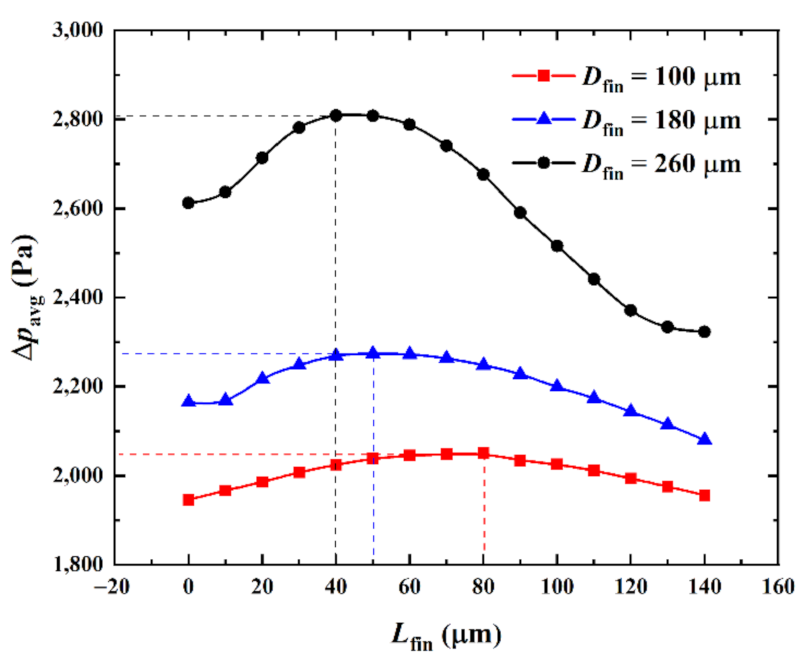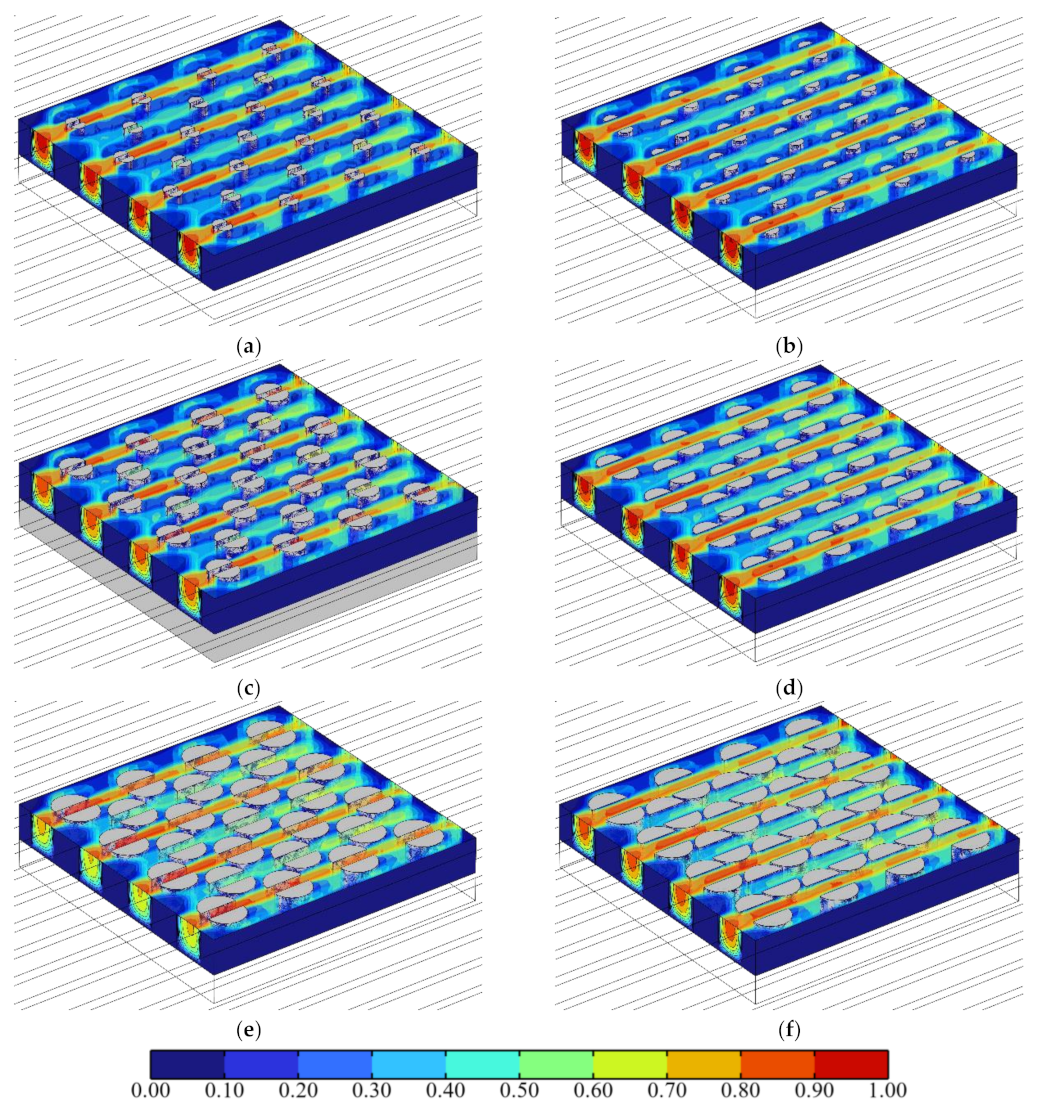3.1. Thermal Behavior and Optimization
- (1)
With different heat fluxes at the hotspot
Figure 7 shows the influence of the heat flux
qhs in the hotspot on the relationship between the maximum temperature
Tmax and the splitting distance
Lfin when the inlet Reynolds number was
Re = 200 and the pin-fin diameter was
Dfin = 180 μm.
Figure 7 shows that when
qhs was specified and as
Lfin increased,
Tmax first marginally increased, then substantially decreased, and finally increased again. The fluid flow rate in the interlayer of the split pin-fins was highly marginal when
Lfin was marginal. This was due to the influence of the boundary layer. At this time, the main heat transfer mode was heat conduction and the convective heat transfer made a limited contribution to the heat dissipation effect. Simultaneously, the vertical streamline length of the pin-fins increased, the flow stagnation area of the back flow side of the pin-fins increased, and the heat dissipation performance decreased. Thus,
Tmax increased with the increase in
Lfin. As
Lfin continued to increase, the flow rate of the fluid flowing through the interlayer of the pin-fins gradually increased and the main heat transfer mode became a convective heat transfer. The heat transfer performance of the pin-fins was enhanced and
Tmax decreased accordingly. When
Lfin > 100 μm, the fluid flow on both sides of the pin-fins and the heat dissipation performance on both sides of the surface continued to decrease with the increase in
Lfin. This caused
Tmax to gradually increase.
A comparison of the relationship curves between Tmax and Lfin at different qhs revealed that the curves for qhs = 400 W•cm−2, 500 W•cm−2, and 600 W•cm−2 had a similar variation trend. Here, the curves first marginally increased, then substantially decreased, and finally increased again. Tmax minima were obtained at (Lfin)opt = 100 μm for the three curves under different qhs conditions. This indicated that qhs had no effect on the thermal behavior of the element body. The extreme values of Tmax for the three curves increased with the increase in qhs (i.e., 356.85 K, 368.96 K, and 381.16 K, respectively) with increments of 12.11 K and 12.20 K, respectively. It was observed that when qhs increased, Tmax proportionally increased; these were positively correlated. This was because the increase in qhs increased the heat output of the chip and the heat dissipation load of the heat sink. If the generated heat was not emitted in time, Tmax accordingly increased until a thermal balance was attained. (Tmax)min under different qhs was reduced by 9.84 K, 12.04 K, and 14.16 K, respectively, compared with Tmax = 366.69 K, 381.00 K, and 395.32 K under Lfin = 0 μm (reduction of 2.68%, 3.16%, and 3.58%, respectively). That is, the larger the value of qhs, the more significant the effect of Lfin on Tmax. This implied that the higher the heat flux of the 3D stacked chip, the more significant the optimization effect of varying the needle rib splitting distance on the maximum temperature.
- (2)
With different Reynolds numbers at the microchannel entrance
Figure 8 shows the influence of the inlet Reynolds number (
Re) on the relationship between the maximum temperature
Tmax and the splitting distance
Lfin when the heat flux in the hotspot was
qhs = 500 W·cm
−2 and the pin-fin diameter was
Dfin = 180 μm.
Figure 8 shows that when the
Re was specified and as
Lfin increased,
Tmax marginally increased, then decreased, and finally increased again. A comparison between the relationship curves of
Tmax and
Lfin for different
Re revealed that the curves for
Re = 100, 200, and 300 had a similar trend. When
Re differed, the three curves achieved a
Tmax minima at (
Lfin)
opt = 100 μm with extreme values of 400.46 K, 368.96 K, and 355.93 K, respectively, and incremental values of −31.50 K and −13.03 K, respectively. The overall heat transfer coefficient
havg corresponding with these
Tmax minima were 30,290 W·m
−2·K
−1, 35,077 W·m
−2·K
−1, and 38,432 W·m
−2·K
−1, respectively. It was observed that for the same model, the fluid flow rate increased and the convective heat transfer effect was enhanced when
Re increased. This, in turn, improves the heat dissipation performance of the heat sink and decreased
Tmax. The larger the value of
Re, the smaller the effect of varying
Re on
Tmax. That is, an appropriate increase in
Re when it was small could reduce
Tmax more effectively. (
Tmax)
min under different
Re was reduced by 11.19 K, 12.04 K, and 11.19 K compared with
Tmax = 411.65 K, 381.00 K, and 367.12 K, respectively, for
Lfin = 0 μm (reduction of 2.72%, 3.16%, and 3.05%, respectively). Therefore, when
Tmax was used as a performance metric, variations in
Tmax were less affected by
Re as
Lfin varied.
- (3)
With different volume ratios (pin-fin diameters)
Figure 9 shows the influence of the pin-fin diameter
Dfin on the relationship between the maximum temperature
Tmax and the splitting distance
Lfin when the heat flux in the hotspot was
qhs = 500 W·cm
−2 and the inlet Reynolds number was
Re = 200. Corresponding with
Figure 9,
Figure 10 shows the temperature color maps of the hotspot area of the hybrid heat sink when
Dfin = 180 μm and
Lfin = 10, 100, and 140 μm, respectively.
As can be observed from
Figure 9, when
Dfin = 180 μm and 260 μm and as
Lfin increased,
Tmax marginally increased, then decreased, and finally increased. When
Dfin = 100 μm and as
Lfin increased,
Tmax first decreased and then increased. When
Dfin = 180 μm and 260 μm,
Tmax passed through three stages as
Lfin increased. The first stage was where
Lfin was small. Here, the main heat transfer mode in the interlayer of the split pin-fins was heat conduction owing to the influence of the small fluid flow rate in the boundary layer.
Tmax marginally increased with the increase in
Lfin. When
Dfin = 180 μm, the
Tmax maximum in the first stage was 381.96 K and the corresponding overall heat transfer coefficient
havg was 33,612 W·m
−2·K
−1. In the second stage,
Lfin continued to increase, the flow-around effect increased, the disturbance of the fluid flow increased, the convective heat transfer effect increased and became the dominant heat transfer mode, and
Tmax accordingly decreased. When
Dfin = 180 μm, the
Tmax minimum in the second stage was 368.60 K and the corresponding overall heat transfer coefficient
havg was 35,067 W·m
−2·K
−1. The third stage was when
Lfin increased to a certain value. With the increase in
Lfin, the fluid mainly flowed through the interlayer of the pin-fins and the convective heat transfer effect on the semicircular surface of the pin-fins weakened. This resulted in an increase in
Tmax. When
Dfin = 180 μm and
Lfin = 140 μm,
Tmax was 373.23 K and the corresponding overall heat transfer coefficient
havg was 34,527 W·m
−2·K
−1. When
Dfin = 100 μm, the obtained data did not reflect the first stage of
Tmax because the numerical simulation calculation step (10 μm) was large. These showed a decreasing trend followed by an increasing trend with the increase in
Lfin.
When Dfin was 100 μm, 180 μm, and 260 μm, Tmax attained a minimum value when (Lfin)opt = 110 μm, 100 μm, and 90 μm, respectively. The extreme values were 382.57 K, 368.96 K, and 368.13 K, respectively, and the increments were −13.61 K and −0.83 K, respectively. Tmax was reduced by 12.48 K, 12.04 K, and 5.52 K compared with Tmax = 395.05 K, 381.00 K, and 373.65 K, respectively, for Lfin = 0 μm (reduction of 3.15%, 3.16%, and 1.48%, respectively). It was observed that with the increase in Dfin, the surface area of the pin-fin heat transfer and the heat transfer increased. The smaller the value of (Lfin)opt, the less optimal the Tmax that was obtained by varying Lfin. Furthermore, the smaller the value of Dfin, the more significant the effect of varying Dfin and Lfin was on Tmax. This indicated that Dfin and Lfin had optimal matching issues when Tmax was considered to be the performance index. Therefore, in practical engineering applications, the pin-fin diameter can be determined by comprehensively considering the cost, process, and other factors. (Lfin)opt can then be determined according to the relationship curve between Lfin and Tmax so that the heat sink Tmax is minimized and the performance is optimal.
3.2. Hydrodynamic Behavior Analysis
- (1)
Influence of the heat flux at the hotspot
Figure 11 shows the influence of the heat flux
qhs at the hotspot on the relationship between the average pressure drop ∆
pavg of the center passage and the splitting distance
Lfin when the inlet Reynolds number was
Re = 200 and the pin-fin diameter
Dfin = 180 μm.
As can be observed from
Figure 11, when
qhs was given and as
Lfin increased, ∆
pavg marginally increased, then substantially increased, and finally continuously decreased. When
Lfin was small, the fluid flow in the interlayer of the split pin-fins was gradual and the disturbance was weak owing to the influence of the boundary layer. However, the increase in the thickness of the split pin-fins in the vertical streamline direction obstructed the fluid flow. This marginally increased the flow resistance and ∆
pavg increased with it. When
Lfin > 10 μm and continued to increase, the fluid flow in the split pin-fin interlayer gradually increased, so that part of the fluid flowed through the split pin-fin interlayer, the disturbance was enhanced, the flow resistance increased, and ∆
pavg greatly increased. When
Lfin > 50 μm and with the increase in
Lfin, the fluid flow on both sides of the pin-fins gradually decreased, the fluid mainly flowed through the interlayer of the split pin-fins, the disturbance weakened, and ∆
pavg continued to decrease.
A comparison of the relationship curves between ∆pavg and Lfin for different qhs revealed that the curves for qhs = 400 W·cm−2, 500 W·cm−2, and 600 W·cm−2 essentially overlapped. Moreover, ∆pavg attained a maximum when (Lfin)opt = 50 μm. A minimum value of 2079.9 Pa was obtained at (Lfin)opt = 140 μm. This was 84.8 Pa lower than ∆pavg = 2164.7 Pa for the cylindrical pin-fins at Lfin = 0 μm (a reduction of 3.92%). It was observed that the variation in qhs essentially had no effect on ∆pavg. This was because the effect of the variation in qhs only altered the temperature field. However, the microchannel retained a single-phase incompressible laminar flow (Re = 200; the fluid was liquid and the physical properties did not vary with the temperature). Thus, the variation in the temperature field at a certain range had no effect on the fluid flow and the flow field and ∆pavg were not affected by qhs. In addition, from the perspective of the fluid flow, increasing the pin-fin splitting distance to the maximum extent within the range permitted by the manufacturing process could be considered. This would reduce the pressure drop in the flow passage and the pump power consumption.
- (2)
Influence of the Reynolds number at the microchannel entrance
Figure 12 shows the influence of the Reynolds number (
Re) at the entrance of the microchannel on the relationship between the average pressure drop ∆
pavg in the center passage and the splitting distance
Lfin when the heat flux in the hotspot was
qhs = 500 W·cm
−2 and the pin-fin diameter was
Dfin = 180 μm.
As can be observed from
Figure 12, when
Re was specified and as
Lfin increased, ∆
pavg marginally increased, then substantially increased, and finally continuously decreased. A comparison of the relationship curves of ∆
pavg and
Lfin for different
Re revealed that the curves for
Re = 100, 200, and 300 had a similar variation trend. ∆
pavg attained the maximum when (
Lfin)
opt = 60 μm, 50 μm, and 40 μm and the respective minimums were 964.7 Pa, 2079.9 Pa, and 3298.0 Pa when (
Lfin)
opt = 140 μm, respectively. The increments were 1115.2 Pa and 1218.1 Pa, which were 9.8 Pa, 84.8 Pa, and 191.8 Pa lower than ∆
pavg = 974.5 Pa, 2164.7 Pa, and 3489.8 Pa when
Lfin = 0 μm. The reduction percentages were 1.00%, 3.92%, and 5.50%, respectively. It was observed that the flow velocity and flow resistance increased as
Re increased and ∆
pavg required by the flow accordingly increased. The higher the value of
Re, the higher the impact of ∆
pavg on the
Re variations. That is, the effect of reducing the heat sink ∆
pavg by reducing
Re was better when
Re was small. In addition, when
Re was large, the fluid flow rate was large, the disturbance was strong, the fluid was substantially affected by the variation in the pin-fin geometric parameters,
Lfin had a more significant effect on ∆
pavg, and the optimization space was larger. Therefore, in engineering applications, the higher the value of
Re, the higher the significance of the optimal design related to the pin-fin splitting distance.
- (3)
Influence of the volume ratio (pin-fin diameter)
Figure 13 shows the influence of the pin-fin diameter
Dfin on the relationship between the average pressure drop ∆
pavg in the center passage and the splitting distance
Lfin when the heat flux in the hotspot was
qhs = 500 W·cm
−2 and the inlet Reynolds number was
Re = 200. Corresponding with
Figure 13,
Figure 14 shows the velocity color maps of the hotspot area of the hybrid heat sink when ∆
pavg reached the maxima and minima at
Dfin = 100, 180, and 260 μm, respectively.
As can be observed from
Figure 13, as
Lfin increased from 0 μm to 140 μm, the fluid flow in the microchannel underwent a process wherein it mainly flowed through both sides of the pin-fins to the interlayer of the split pin-fins. The fluid disturbance first increased and then weakened. ∆
pavg varied with it; increasing first and then continuously decreasing. A comparison between the relationship curves of ∆
pavg and
Lfin with different
Dfin revealed that for
Dfin = 100 μm, 180 μm, and 260 μm, ∆
pavg attained the maximum value when
Lfin = 80 μm, 50 μm, and 40 μm, respectively. Meanwhile, the minimum values were obtained when
Lfin = 0 μm, 140 μm, and 140 μm (namely, 1946.1 Pa, 2079.9 Pa, and 2322.7 Pa, respectively, with increments of 133.8 Pa and 242.8 Pa, respectively). Compared with ∆
pavg = 1946.1 Pa, 2164.7 Pa, and 2612.4 Pa for
Lfin = 0 μm, it was reduced by 0 Pa, 84.8 Pa, and 289.7 Pa, respectively (i.e., by 0%, 3.92%, and 11.09%, respectively). It was observed that the larger the
Dfin, the smaller the minimum value of ∆
pavg. Furthermore, the larger the decrease with the increase in
Dfin, the larger the variation in the influence of
Lfin. That is, the larger the
Dfin, the higher its influence on ∆
pavg. Compared with the cylindrical pin-fin hybrid heat sink when
Lfin =0 μm and when ∆
pavg was taken as the performance index, the larger the
Dfin, the better the optimal performance that could be achieved by tweaking
Lfin for the heat sink. In addition, when
Dfin = 100 μm, the minimum value of ∆
pavg was
Lfin = 0 μm. The cylindrical pin-fins then formed the optimal configuration.
3.3. Comprehensive Performance of the Microchannel Pin-Fin Hybrid Heat Sink
From the above thermal and hydrodynamic behavior analysis of the microchannel pin-fin hybrid heat sink, the influences of the flow and structure parameters on the maximum temperature Tmax and the overall heat transfer coefficient havg of the hybrid heat sink were exactly contrary to the average pressure drop ∆pavg of the center passage of the hybrid heat sink. This indicated that it was necessary to further confirm if the comprehensive performance of the microchannel pin-fin hybrid heat sink was better than the conventional microchannel heat sink.
The performance evaluation criteria
is a well-known and widely used indicator to describe the comprehensive performance of heat sinks [
23].
Nu is the overall Nusselt number,
f is the apparent flow friction coefficient, the subscript “0” indicates the conventional microchannel heat sink, and the subscript “a” indicates the microchannel pin-fin hybrid heat sink.
When the heat flux in the hotspot
qhs = 500 W·cm
−2 and the Reynolds number
Re = 100~300, the apparent flow friction coefficients
f0 of the conventional microchannel heat sink with the exact dimensions as
Table 1 were 0.1652, 0.0871, and 0.0591, respectively; the overall Nusselt numbers
Nu0 of the conventional microchannel heat sink were 13.958, 15.674, and 16.842, respectively. The above parameters were used as the benchmark to compare the comprehensive performance of the microchannel pin-fin hybrid heat sink.
Considering the effect of the Reynolds number (Re) and the splitting distance Lfin on the comprehensive performance of the microchannel pin-fin hybrid heat sink (Dfin = 180 μm), PEC = 0.8595 when (Lfin)opt = 100 μm at Re = 100, PEC = 1.2248 when (Lfin)opt = 100 μm at Re = 200, and PEC = 1.5131 when (Lfin)opt = 100 μm at Re = 300, respectively. This indicated that the comprehensive performance of the microchannel pin-fin hybrid heat sink was not good at small Reynolds numbers, but could be significantly improved as the Reynolds number gradually increased.
Considering the effect of the pin-fin diameter Dfin and the splitting distance Lfin on the comprehensive performance of the microchannel pin-fin hybrid heat sink (qhs = 500 W·cm−2; Re = 200), PEC = 1.1607 when (Lfin)opt = 110 μm at Dfin = 100 μm, PEC = 1.2217 when (Lfin)opt = 100 μm at Dfin = 180 μm, and PEC = 1.2312 when (Lfin)opt = 100 μm at Dfin = 180 μm, respectively. This indicated that, at a given Reynolds number, the thermal performance and the comprehensive performance of the microchannel pin-fin hybrid heat sink could be further improved with a bigger pin-fin diameter Dfin and corresponding optimal value of the splitting distance (Lfin)opt.
